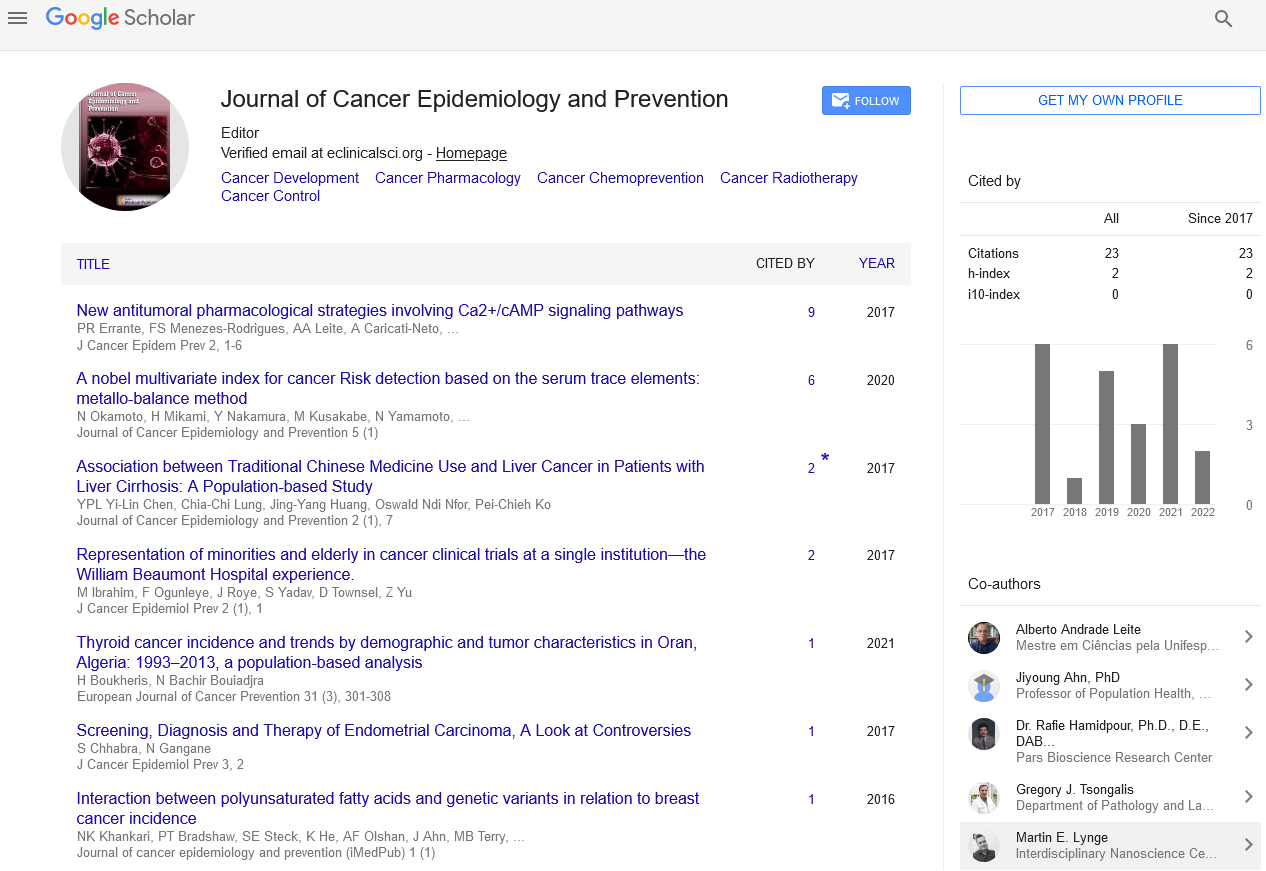Keywords
Breast cancer; Cancer screening
Introduct ion
As shown by many previously conducted studies, the stage of
detection, or any cancer for that matter, has a great degree of
influence on the survival rate for patients.
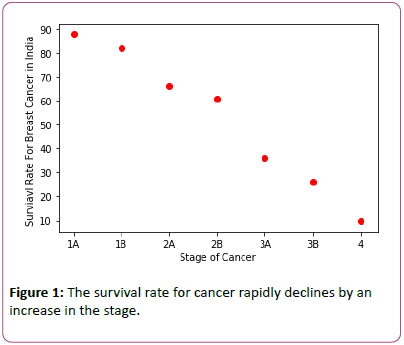
Clearly indicated by the graph above, the survival rate for
cancer rapidly declines by an increase in the stage.
In India, the survival rate for breast cancer patients is a mere
50-60% when compared to that of developed countries such as
the United States of America, United Kingdom, Australia, where
the breast cancer survival rates are as high as 80%. This can be
attributed to significantly lower screening rates prevalent in
India. There are a few reasons for the lower survival rate in
India:
• Lack of awareness about breast cancer and the signs to detect
it
• Unavailability of proper medical facilities and infrastructure to
provide screening facilities
• Expensive procedures to screen for breast cancer
• No large-scale screening program for breast cancer in India
• Societal stigma in India associated with breast cancer
Discussion
General respondent data:
Participant Data (Age):
Ø22.6% were of age 18-20
Ø1.9% were of age 20-30
Ø16% were of age 30-40
Ø39.6% were of age 40-50
Ø13.2% were of age 50-60
Ø5.7% were of age 60-70
Ø0.1% were of age greater than 70
Participant Data (Monthly household income in INR):
Ø28.3% were of the group <2 lakhs
Ø27.4% were of group 2 lakhs-5 lakhs
Ø17% were of the group 5 lakhs to 8 lakhs
Ø27.4% were of the group >8 lakhs
Other Participant Data: Among those surveyed, 39% of
respondents had got screened while 61% of them had not
screened. Among those who had not got screened, these were
the primary reasons.
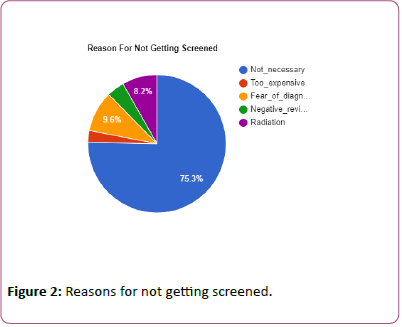
• Blue segment: Did not consider screening to be necessary
• Red segment: Screening was too expensive
• Yellow segment: Was afraid of being diagnosed with breast
cancer
• Green segment: Heard negative reviews about screening from
someone else
• Purple segment: Was uncomfortable with the level of
radiation during conventional screening procedures
Hence the majority of participants felt that screening was not
necessary, which will be addressed in the awareness section of
this paper.
Correlation Analysis for Different Parameters
For those who have got screened
The parameters we will analyse are age, monthly household
income, whether or not the participant showed symptoms of
breast cancer or not, previous family history of breast cancer,
how recently the participant had gotten screened, the amount they paid to get screened, whether or not they recommended
screening to others, their perception of societal stigma around
breast cancer, how much they would be willing to pay in the
future to get screened, how often were they recommended
follow-up screening, and whether or not their screening was
covered for by insurance or paid by employers. Do note that this
analysis is only corresponding to the data for those who had
gotten screened for breast cancer

• How recently a respondent had gotten screened and whether
or not they recommended it to someone else have a strong
positive correlation. This may be due to improvement in
screening facilities, realising the need to spread awareness to
screen for breast cancer and the general increase in screening
rates over the past few years
• Due to moderate positive correlations between whether or
not a person showed symptoms of breast cancer, how much
they paid for getting screened, and how much they would be
willing to pay next time, we can infer that seeing tangible
symptoms of breast cancer development may lead to people
being willing to pay more to get screened
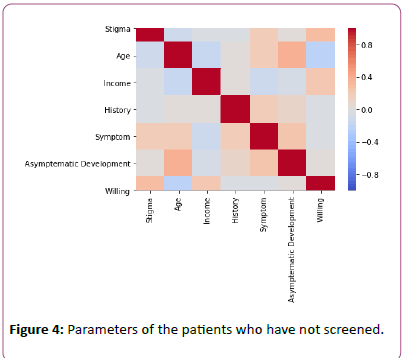
• Additionally, those with symptoms were recommended follow
up screenings more recently compared to those who did not
exhibit symptoms. This may be due to the symptoms being
identifiable at a later stage and hence requiring more regular
screenings to be affirmed as breast cancer
• Those with familial histories of breast cancer also paid higher,
again possibly due to the prospective patients being willing to
pay more due to them being at a higher risk of acquiring
breast cancer
• Also, those who paid more currently are also much more likely
to pay more in the future to get screened for breast cancer,
indicated by a strong positive correlation between the two
factors. This may indicate higher levels of awareness about
regular screening and its necessity or a satisfactory screening
experience. The latter can be quantitatively supported since
59.6% of respondents who had gotten screened indicated no
problem in the screening procedure or experience
For those who have not got screened
For this category, the parameters we will inspect are age,
monthly household income, previous familial history of breast
cancer, awareness about breast cancer development without
exhibiting any symptoms, how much stigma they perceive
around breast cancer to be prevalent around them, whether or
not a participant has shown symptoms, and how much they
would be willing to pay to get screened
• Among those who have not gotten screened yet, age and
knowledge of asymptomatic development of breast cancer
have a strong positive correlation, indicating that the overall
lower screening rate among the younger demographic may be
due to them not considering it necessary since they might be
relatively unaware about asymptomatic tumour development
• As expected, income and amount one is willing to pay to get
screened have a positive correlation. Unexpectedly though,
it’s of a low degree, indicating that the difference between the
amounts that someone of a household income of Rs 8 lakhs a
month and someone of a household income of Rs 2 lakhs a
month is not all that different
Lack of Awareness
The lack of awareness about breast cancer ranges from lack of
awareness about its prevalence to a lack of awareness about the
necessity of being screened to a lack of awareness about to a
lack of awareness about early detection
• Among those surveyed, only 41% of people affirmed to know
of breast cancer developing without showing any symptoms.
Majority of the respondents were either unaware of breast
cancer developing without showing any symptoms (44.6%) or
did know that it developed without symptoms, but did not
consider it to be of great significance (14.5%). These rates are
reflected in the greater population too, where more than 70%
of breast cancer cases are diagnosed in stage III or later
• Additionally, of the people we surveyed, 74.6% of the people
did not consider screening to be necessary and hence did not
get screened
Psychological Barrier
Another aspect to consider when analysing why the screening
rate for breast cancer in India is so low is that women may face
psychological barriers when coming to terms with the fact that
there might be a chance of them being diagnosed with breast
cancer. Firstly, their knowledge of breast cancer survival rates
prevalent would be very low, and hence might be deterred from
wanting to be diagnosed with such a deadly disease.
Additionally, in Indian society even today, many women feel that
breast cancer as an issue is highly stigmatized, and hence they
might not feel at ease to discuss the probability of getting
screened and seek out the necessary support to overcome the
mental blockade of knowing of the high mortality rate of the
disease. Close to 9.6% of respondents who did not undergo
screening stated fear of diagnosis as the primary reason for not
having gotten screened yet.
When asked if they felt a certain amount of stigma associated
with breast cancer in society today, these were the responses:
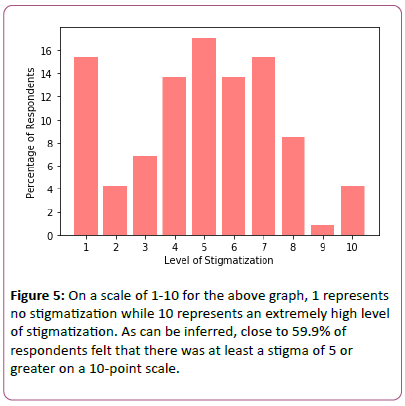
Financial Barrier
• In our study conducted, the majority of the participants had a
high income and hence did not state a lack of finances as a
reason for not getting screened. However, there were
participants who stated a lack of finances preventing them
from getting screened. These were 3% of the group which had
not gotten screened yet Additionally, all the participants who had shown symptoms of
breast cancer but did not get screened cited screening being
too expensive as the reason. Also, all of these participants belonged to the <Rs 200000 per month of household income
group
Overdue in Screening
• According to Dr Mathangi J, a radiation oncologist at BGS
Global Hospitals, women should start self-examination every
month, seven days after their period (because the breasts may
be tender before that), from the age of 20. Post-menopausal
women or those who do not have periods for any other reason
can fix a day for self-examination each month
• Additionally, according to the American Cancer Society,
women over the age of 40 should undergo annual
mammography screenings to detect signs of breast cancer
developments
• In our study conducted, 48.9% of the women were not
recommended follow-up screening at all, which may not be
beneficial since the risk of developing breast cancer increases
significantly with age, and regular screening to identify the
same would be necessary
• Additionally, 6.9% of respondents have advised follow-up
screening every 10 years or more frequently. This advised time
span of 10 years might be too long a period, which may allow
a tumour to develop in the interim period without being
screened until it has reached a fatal later stage
Recommendations
• To counter the lack of awareness and stigmatization previously
discussed, mass media infomercials may help make a change.
With over 100 million television viewers in urban India, and
approximately 64% of Indians listening to a radio FM station at
least once a day, awareness about breast cancer symptoms
and how to detect them, the necessity for screening/early
detection, and that breast cancer can develop while being
asymptomatic, till it reaches a later stage where it might be
fatal. These media infomercials can also be greatly helpful in
sensitizing the population to breast cancer as a whole, paving
the way for progress to overcome certain psychological
barriers women may face preventing them from getting
screened
• For trying to increase breast cancer screening on a population
level, the implementation of breast cancer blood-based
markers to detect progesterone receptors and estrogen
receptors can be used, one example of such a blood-based
marker test is the CA 15-3 test. This test costs around Rs 1500
to conduct in most labs in the NCR region, which would hence
place it perfectly in the price bracket that most respondents
would be willing to pay to get screened. Additionally, such a
test would omit the problem of patients being deterred from a
test due to its invasive nature or radiation levels, while also
providing a more scalable model for a population level
screening project
• To help financially aid the people who may deem screening to
presently be too expensive, there should be an aid in the
forms of government funds created to help screening
programs across diseases. Presently, the major funds created
are for treating fatal diseases once they have been diagnosed.
However, as numerous studies previously have shown, the
cost of treatment of breast cancer detected at stage 3B can be
up to 3.6 times the cost of treatment of breast cancer
detected at stage 1. Hence the provisioning of such a fund will
allow a lesser burden financially since the cost of treatment of
most diseases is significantly lower when detected at an
earlier stage
• Currently, in India, there is no organised mass breast cancer
screening program. The creation of such a program will
sensitize the population to the issue, achieve better screening
rates, both directly from the screening program and indirectly
from the destigmatization of the issue coupled with better
financial backing for those seeking screening services
• For those who have undergone screening, more regular follow
up screening should be prescribed to account for the growing
risk of developing breast cancers with the increase in age
References
- Takkar N, Kochhar S, Garg P, Pandey AK, Dalal UR, et al. (2017)
Screening methods (clinical breast examination and
mammography) to detect breast cancer in women aged 40–49
years. J Mid life Health 8: 2-10.
- Khokhar A (2015) Study on knowledge experiences and barriers to
mammography among working women from Delhi. Indian J
Cancer 52: 531-535.
- Singh R, Shetty N, Rai P, Yadav G, Gandhi M, et al. (2018) Breast
cancer awareness among women in an urban setup in Western
India. Indian J Med Paediatr Oncol 39: 215-218.
- Zura K, Rakesh R, Willie Y (2017) Estimating Cost Savings from
Early Cancer Diagnosis MDPI 2: 30.
- Sandeep S, Jyoti P, Ankit D (2015) Breast cancer screening
existence in India: A nonexisting reality. Indian J Med Paediatr
Oncol 36: 207-209.
- William F (1994) Barriers to breast cancer screening in older
women: A review. Journal of Nurse Midwifery 39: 283-299.






